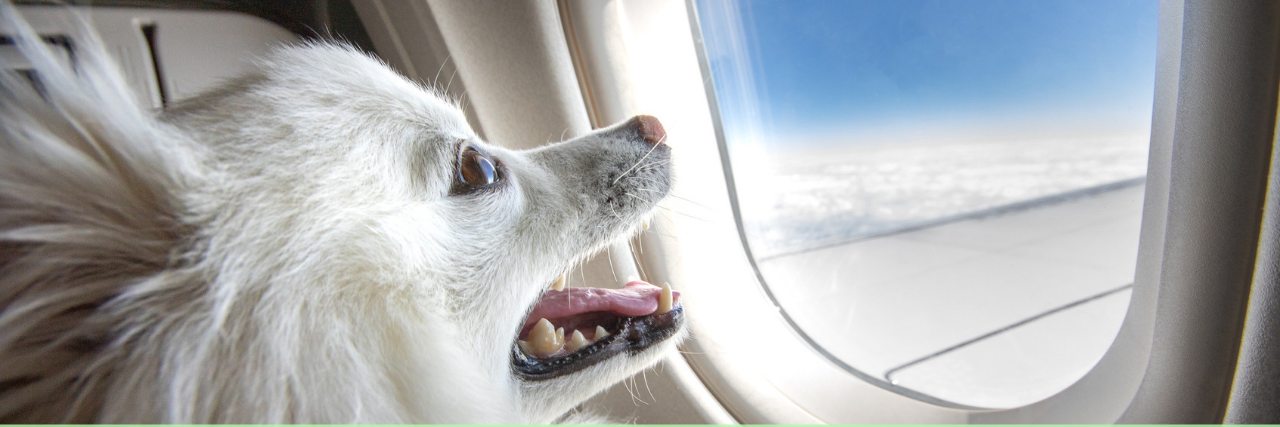An emotional support animal (ESA) is distinct from service animals and is often a soothing presence for people with a chronic illness, disability or mental health condition. Last year, for example, a study was published that showed an animal or pet can have psychological benefits and can even affect pain perception. These animals assuage the difficulties of managing day-to-day life.
There’s also plenty of anecdotal evidence to back this up. Mighty contributor Taylin explained how their emotional support cat is supportive in the article, “Why Depression Means I Am Allowed a Pet on Campus.” Taylin wrote:
Unfortunately, waking up to feed myself and simply take care of my basic needs is not enough motivation to wake up, but taking care of her is. If I don’t take care of her, nobody else will. She gives me the motivation to live. She loves me unconditionally and on days I can’t see any good in myself, she reminds me I am able to be loved.
The benefits of an ESA can be even more important when you travel, which may be extra stressful. However, it’s not always easy when flying with an ESA. In the past year, a number of airlines have been altering their ESA policies in response to a growing number of incidents. For some airlines, that means adding more documentation, banning certain types of animals or requiring more in-cabin restrictions for animal passengers.
With all the changes being made to airline ESA policies, we compiled a list of essential things you need to know for successfully traveling with your ESA on the nine biggest airlines flying in the United States, including Alaska, Allegiant, American, Delta, Frontier, JetBlue, Southwest, Spirit and United Airlines.
In general, all airlines expect your ESA will be well-behaved and stay in a carrier or on a leash at all times. Anything considered disruptive, like growling at passengers, barking excessively or eating off in-cabin tray tables, could result in extra fees or your animal not being allowed on the flight. In addition, you won’t be able to book a seat in an exit row for safety reasons and your ESA can’t sit in the aisle. Service animals and ESAs travel for free when you have all the correct documentation.
Here are additional specifics you’ll want to know ahead of time listed by airline in alphabetical order.
Alaska Airlines

Alaska Airlines offers flights to over 115 destinations in the U.S., Canada, Mexico and Costa Rica. In 2017, over 20 million people flew through Alaska Airlines and their track record for animal safety is pretty good — they reported only three negative incidents.
Animals Permitted
- Only allows cats and dogs
- You can only travel with one ESA
What You Have to Do Ahead of Time
- Submit a health and vaccination form and confirm your ESA is trained to behave in public
- Get a mental health form signed by a professional confirming you need an ESA
- Sign an animal behavior form agreeing to Alaska’s guidelines for your animal
- All documents must be submitted at least 48 hours prior to your flight
Once You’re on the Flight
Animals onboard can’t take up more space than the area at your feet or your own seat. Your ESA is not allowed to occupy a seat and the airline recommends you book a window seat to keep animals out of the way of foot traffic.
For more information on ESA regulations for Alaska Airlines and to download the forms you need, visit its website.
Allegiant Air

It may not be the most recognizable name, but Allegiant Air is the ninth largest U.S. airline. It flies to over 100 destinations in the U.S. with over 12 million passengers each year.
Animals Permitted
- Only allows cats, miniature horses and dogs (excluding pit bull breeds)
What You Have to Do Ahead of Time
- Get a signed Allegiant form from a mental health professional or doctor saying you need to fly with an ESA
- Complete a veterinary form with a record of your ESA’s health and vaccinations
- Sign an animal behavior and responsibility form, acknowledging Allegiant’s ESA policies and that you’ll pay for any damages your ESA may cause
- All documents must be presented at least 45 minutes prior to your flight
Once You’re on the Flight
All animals must remain on the floor, under the seat or in your lap and on a leash or in a carrier at all times. If you plan to have your ESA sit on your lap during the flight, they must be about 30 pounds or less.
For more information on ESA regulations and to get the form you have to fill out for Allegiant Air, visit its website.
American Airlines

American Airlines, the biggest airline in the U.S., flies to over 350 locations in 50 countries and, in 2017, flew over 34,000 animals. If you’re worried about safety, in 2017, it was reported that two animals died and one was injured while flying with the airline.
Animals NOT Permitted
- Amphibians, reptiles and snakes
- Ferrets, hedgehogs, rodents and sugar gliders
- Goats and other animals with tusks, horns or hooves (excluding miniature horses trained as service animals)
- Insects and spiders
- Non-household birds (chickens, birds of prey)
- Any animal that is dirty or smells
What You Have to Do Ahead of Time
- Have your therapist or psychiatrist sign a mental health professional form confirming you require an ESA (American will call your doctor to confirm all this information)
- Fill out a form accepting liability for your animal
- For flights over 8 hours, you’ll need to sign another form that says your animal won’t relieve themselves on the flight and will act appropriately
- You must contact the American Airlines Special Assistance Desk at least 48 hours before your flight with completed documents
Once You’re on the Flight
Animals have to sit by your feet, under the seat in front of you or in your lap. They must be either in a carrier or on a leash or harness. They can be kept on your lap in-flight if they are smaller than a 2-year-old child. If these options don’t work, you may need to book another flight, buy an individual seat ticket for your ESA or check your pet to travel under the plane.
You can find additional information on ESA regulations and the forms you’ll need for American Airlines on its website.
Delta Airlines

Delta Airlines is one of America’s largest airlines, and carries over 250,000 service and support animals annually — a 150 percent increase since 2015. While it only reported 2 deaths and 1 injured animal in 2017, Delta has had an 84 percent increase in incidents with animals on planes, such as peeing, pooping and even biting.
Animals NOT Permitted
- Pit bull-type dogs
- Hedgehogs, ferrets and sugar gliders
- Insects and spiders
- Rodents
- Snakes, reptiles and amphibians
- Goats or other animals with tusks, horns or hooves
- Non-household birds
- Any dirty or smelly animal
- ESA must be at least four years old (due to rabies vaccination requirements)
- Not allowed on flights longer than eight hours
- You can only fly with one ESA
What You Have to Do Ahead of Time
- Submit a form saying your ESA is trained to behave in public and you take full responsibility for their behavior
- Sign an acknowledgment form confirming you understand and agree to Delta’s policies
- Submit a completed health and vaccination record for your ESA
- Your mental health professional must sign a letter (that will be valid for one year) that your ESA is necessary
- All forms must be submitted to Delta’s Service Animal Support Desk at least 48 hours before travel
- You must use the full-service check-in process with an airport agent if you wish to bring your ESA
Once You’re on the Flight
Support animals may sit at your feet as long as no part of the animal extends into the aisle. An alternative option, if your ESA is smaller than a 2-year-old child, is to let your ESA ride in your lap. You must have your ESA at your side at all times and your animal cannot occupy a seat.
For more information on ESA regulations and to download the forms you’ll need for Delta Airlines, visit its website.
Frontier Airlines

Frontier Airlines flies to over 100 U.S. destinations and in 2017 served over 16 million passengers. While reported animal incidents are low, in October 2018, a woman was barred from bringing her ESA squirrel on a Frontier Airlines flight.
Animals Permitted
- Only allows cats and dogs
- You may travel with only one ESA
What You Have to Do Ahead of Time
- Submit an animal behavior form that outlines the airline’s animal policies, acknowledging you will be held responsible for any damages or disruptions
- Your mental health professional must sign a letter confirming you have a mental health diagnosis, are in professional care and need an ESA for travel
- All documents need to be submitted to Frontier Airlines at least 48 hours before your flight, which you can upload on Frontier’s website
In-Cabin Policy
ESAs must either be in a carrier and stowed under your seat or be on a harness/leash on the floor in front of you or on your lap. You can only have your ESA on your lap during the flight if they are smaller than a 2-year-old child.
For more information on ESA regulations for Frontier Airlines and to download the forms you’ll need, visit its website.
JetBlue Airways

JetBlue is one of the largest U.S.-based airlines and has a positive reputation regarding animals. For example, in 2018 a French Bulldog began having difficulty breathing on a flight. The crew used its oxygen mask to stabilize his breathing, showing that JetBlue knows animals are like family.
Animals Permitted
- Only allows dogs, cats and miniature horses
- You can only bring one ESA
Forms Required
- Submit a veterinary health form that includes vaccination records for your ESA
- Have your mental health provider fill out a form acknowledging your mental illness or disability and you need an ESA for treatment and travel
- Sign the confirmation of animal behavior form, which will also show you understand JetBlue’s ESA policy and procedures
- All documents must be submitted to JetBlue Airways at least 48 hours prior to your flight, which you can upload online
In-Cabin Policy
Your ESA must sit at your feet and not extend into the aisle. You can only have your ESA sit on your lap if they are as small as an infant. Otherwise, they must stay on the floor at all times. ESAs are not allowed to occupy a seat.
For more information on ESA regulations and to download required forms for JetBlue, visit its website.
Southwest Airlines

Southwest Airlines flies to over 100 destinations in the U.S., but when it comes to animals, it isn’t incident-free. For example, a 70-pound dog scratched the face of a passenger when she went into pet it. That same year, a student reported she lost her pet fish after it was banned from a Southwest Airlines flight.
Animals Permitted
- Only cats and dogs are permitted
- Your ESA must be at least four years old
- You can only travel with one ESA
Forms Required
- Your licensed mental health professional or medical doctor must submit a letter saying you are under their treatment, have a mental illness or disability and an ESA is needed for travel
- Although you may submit the form at the airport, it is recommended you contact Southwest Airlines prior to your flight
- Know that Southwest Airlines staff may question you to make sure your animal is for emotional support at any point before or during your flight
In-Cabin Policy
Your ESA must either be in a carrier stowed under your seat or have a harness/leash on at all times. Your ESA must be as small as a two-year-old child if you plan to have it sit on your lap.
For more information on ESA regulations for Southwest Airlines and to download the forms you need, visit its website.
Spirit Airlines

Spirit Airlines is known for its low ticket prices but notorious for poor service and a high rate of complaints. Though few animal incidents have been reported safety-wise in-flight, Spirit was involved in one of the most infamous airline ESA incidents.
In 2018, a student’s ESA hamster was refused to board by a Spirit employee, despite calling the airline twice ahead of time to confirm that her ESA could board. A Spirit Airline employee allegedly suggested that the student flush her ESA down the toilet (the airline denies this claim), which the student later did.
Animals NOT Permitted
- Snakes and reptiles
- Rodents, ferrets or sugar gliders
- Spiders
- For other “unusual” animals, call ahead to determine if they will be allowed, and get that in writing!
What You Have to Do Ahead of Time
- Submit a form completed by a mental health professional confirming an ESA is needed for travel
- Sign the passenger acknowledgment form stating you understand Spirit Airlines’ policy and procedures
- Submit your ESA’s health and vaccination records
- For international flights, you may be asked to complete additional documentation and requirements
- All documents must be submitted to Spirit Airlines at least 48 hours prior to your flight, which can be done online
Once You’re on the Flight
Your ESA must sit at your feet, not block the aisle and remain with you at all times. If your ESA is in a pet carrier, you cannot sit in the front row. If you would like to have your ESA on your lap, you cannot sit in a seat with an inflatable seat belt and your ESA must be no larger than a child.
For more information on ESA regulations and the forms you need to fly on Spirit Airlines, visit its website.
United Airlines

United Airlines is one of the largest airlines in the world and based on 2017’s numbers, flew the most animals (over 138,000 of them) in the U.S. But United has a very poor track record regarding animals, with 18 deaths and 13 injured animals in 2017. However, United attributes this to their decision to accept “high-risk” brachycephalic breeds of animals that have a smaller opening in their nose, which makes breathing more difficult.
In another notorious ESA moment, United refused to board an emotional support peacock in 2018. Other animals placed underneath the aircraft and (inexplicably) one in an overhead bin have died in the last couple years. In March 2018, United sent a dog to Japan instead of Kansas by mistake.
Animals Permitted
- Only allows cats and dogs
- Animals must be at least four years of age
- You can only travel with one ESA
- Your ESA cannot be over 65 pounds
- ESAs are not permitted on flights longer than eight hours
What You Have to Do Ahead of Time
- Submit a completed mental health professional form signed by a therapist, psychiatrist or doctor
- Fill out a confirmation of liability for your ESA’s behavior
- Turn in veterinary forms documenting your animal’s health and vaccination records
- Submit all documents to United Airlines at least 48 hours before your flight
Once You’re on the Flight
Your ESA must sit at your feet without protruding into the aisle. You can use an approved in-cabin kennel for smaller animals. If your ESA is not in a carrier, they will need to be leashed at all times in the airport and in-flight.
For more information on ESA regulations for United Airlines and to download the forms you’ll need, visit its website.
What’s been your experience flying with emotional support animals? Let us know in the comments!

